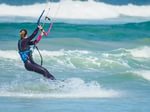Are you ready to buckle up your kite harness? Attach your safety leash and learn what you should know before choosing a waist, seat or boardshorts harness.
The harness is one of the most important equipment items in kiteboarding. Choosing the right harness for your body and style of riding is critical.
It connects you to the kite bar, transferring the pull of the kite from your hands to your body, but it is often overlooked in the kiteboarding world.
The harness also creates a balance zone that enables you to turn, steer, and control your kite with one hand even in the most powerful wind conditions.
Generally speaking, in kiteboarding, you don’t want to experience equipment failure. In the event of gear malfunction, you can be left stranded in the open ocean.
That’s why you should always get and use top quality harnesses, made from resistant materials. Cheap models are not advisable.
Types of Kitesurfing Harnesses
There are two types of kitesurfing harnesses: the waist harness, the seat harness, and the boardshorts harness.

It’s up to the rider to choose which one fits his/her riding best. That is why you should try out a few models and compare features before making a final decision.
Kiteboarding beginners and riders suffering from back pain tend to prefer seat harnesses because they fit around the hips and offer a lower hook point.
Despite its diaper-style, the seat harness is the original kite harness, and it is still used by advanced kite athletes in speed and long-distance races because of its lower center of gravity they provide.
Waist harnesses offer a much freer riding experience and will let your legs move more in the water and while performing tricks and maneuvers.
They are more comfortable to wear, look cooler, and sit between the ribs and the hips. If for any reason, you have to swim a few hundred meters, then the waist harness will always make things easier for you.
There are also waist harnesses with taller back support for free riders or kiteboarders who never unhook and prefer to cruise around, and lower profile models for freestylers.
Wave kitesurfers usually opt for systems with rope instead of a hook so that they slide around and turn abruptly.
For maximum freedom of movement, there’s always the boardshorts harness, a simple concept with a lower hook point.

Kite Harness: Making the Right Choice
The typical kiteboarding harness features a flexible memory foam shell, a (sliding) spreader bar, a hook, a series of straps and power belts, a hook knife, and a leash connector.
But, no matter what your preference is, it’s vital that your harness checks all the following boxes:
1. Comfort: all harnesses should fit snugly without being too loose or too tight. Excessive pressure on the lower ribs will cause discomfort and may force you to interrupt your session earlier;
2. Safety Functions: a good harness features several straps that allow you to tighten it around your waist and prevent it from riding up – a well-hidden knife is always a mandatory tool;
3. Quality of Materials: a model with soft cushioned neoprene, good stitches, a high-end stainless steel hook will never cause breathing problems;
4. The Right Size for Your Body: correct fitting correct fitting one can provide support and reduce muscle fatigue, allowing for a longer and safer kiting session;
When choosing a kite harness, make a rigorous inspection to see if all components were correctly assembled. Analyze the quality of the hard and soft shell and composite materials.





Recent Comments